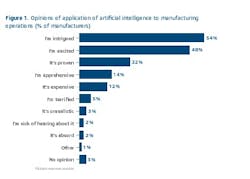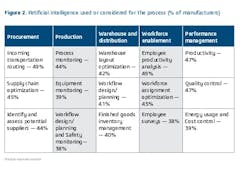The Growing Role of AI in the Manufacturing Industry
Artificial intelligence (AI) is no longer the exclusive domain of high-tech industries; it’s making significant strides in manufacturing, a sector traditionally dependent on manual labor and operator-managed equipment. With advancements in AI technology and a shift in perspective among industry leaders, the narrative surrounding AI in manufacturing is changing rapidly.
The 3DS Technology Barometer Artificial Intelligence study provides valuable insight into how manufacturing executives perceive AI, the investments they’re making and the hurdles they face in adoption. Below, we explore the findings and offer insights for manufacturers ready to take advantage of this technological evolution.
Manufacturing Industry’s Optimism About AI
According to the 3DS Technology Barometer, manufacturing executives increasingly view AI as an opportunity rather than a challenge. Nearly 50% of surveyed executives have favorable opinions about AI, with many expressing optimism and curiosity about its potential. Mid-sized companies, defined as those with revenues between $10 million to $100 million, appear especially intrigued, with 59% expressing interest and 60% feeling excited about AI-powered opportunities.
This enthusiasm underscores the growing recognition of AI’s role in modernizing operations, improving efficiency and driving innovation in production environments that have traditionally been slow to adopt cutting-edge technologies.
Financial Commitments Toward AI
Highlighting their confidence in AI, nearly two-thirds of manufacturers plan to allocate more than 10% of their technology budgets toward AI-driven equipment and solutions in the coming year. This financial commitment is notably higher among industrial equipment manufacturers, with 77% willing to cross the 10% expenditure threshold.
Interestingly, the data reveals a financial gap based on company size. Larger manufacturers, those earning more than $100 million annually, were least likely to dedicate over 10% of their technology budgets to AI, suggesting that agility and innovation may come easier for smaller, mid-sized manufacturers.
Key Areas Where AI is Transforming Manufacturing
AI technologies are proving invaluable across a range of manufacturing applications. Processes that depend on data analytics, predictive insights, and operational efficiency are particularly ripe for AI integration. According to the study, more than half of manufacturing executives consider AI highly applicable in critical areas, including:
1. Warehouse and Distribution
AI is helping redesign warehouse layouts, improve inventory management and optimize logistics. The study finds that 62% of manufacturers see warehouse and distribution activities as highly suitable for AI integration. Tasks such as finished goods management and incoming transportation routing are among the top AI applications.
2. Procurement and Purchasing
AI is also impacting procurement processes. With 55% of manufacturers identifying procurement as an area ripe for AI, the technology is helping identify and assess suppliers, optimize supply chain processes and improve cost-effectiveness.
3. Performance Management
Performance management and improvement rank high among AI applications, as 54% of respondents regard this as an opportunity to leverage AI. By analyzing productivity patterns and tracking energy usage, AI helps ensure smoother and more cost-efficient operations.
4. Production
Fifty percent of manufacturers find production activities to be an ideal ground for AI implementation. From process monitoring to equipment tracking and quality control, AI facilitates smarter production workflows.
5. Workforce Enablement
Far from replacing employees, AI is transforming workforce dynamics by enhancing productivity and providing better tools for decision-making. Tasks such as workforce assignment optimization and productivity analysis are gaining momentum, with 47% of manufacturers already exploring workforce-focused AI applications.
The Challenges Holding Back AI Adoption
Despite the enthusiasm and growing adoption rates, manufacturers face significant challenges in deploying AI effectively. The 3DS Technology Barometer identifies the following barriers as key roadblocks to wider adoption of AI in manufacturing operations:
1. Limited Technology Budgets
For 44% of manufacturers, the cost of AI equipment and solutions remains a concern. While AI often promises improved efficiency in the long run, the upfront investment can be prohibitive for many organizations.
2. Data Quality Issues
Reliable, high-quality data serves as the backbone of any effective AI initiative. Yet, 40% of manufacturers struggle with poor data quality. For AI to provide actionable insights, manufacturers must focus on robust data collection, storage and management practices.
3. Resistance to Change
Cultural resistance and poor change management are major hurdles, with 38% of surveyed manufacturers citing this as a challenge. Implementing AI isn’t just about technology—it also requires skilled teams ready to adapt to new workflows. Building trust and providing training for managers and frontline employees are critical steps in ensuring smooth AI deployments.
Overcoming Challenges with the Right Solutions
AI’s potential in manufacturing is undeniable, from streamlining supply chains to improving employee productivity and ensuring better product quality. While challenges exist, forward-thinking manufacturers leveraging advanced solutions like Solidworks Manufacturing Solutions built on the 3DExperience platform can overcome these barriers efficiently.
Are you ready to bring the power of artificial intelligence to your operations? Start laying the groundwork today by addressing your organization’s data quality, training teams and adopting cutting-edge solutions to stay competitive in an evolving industry landscape.
This article was sponsored by Solidworks.




